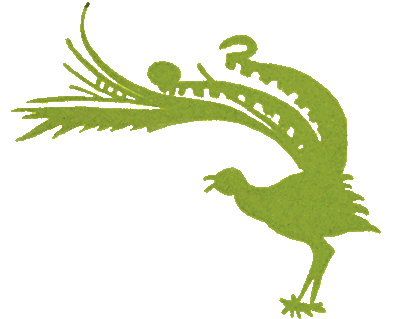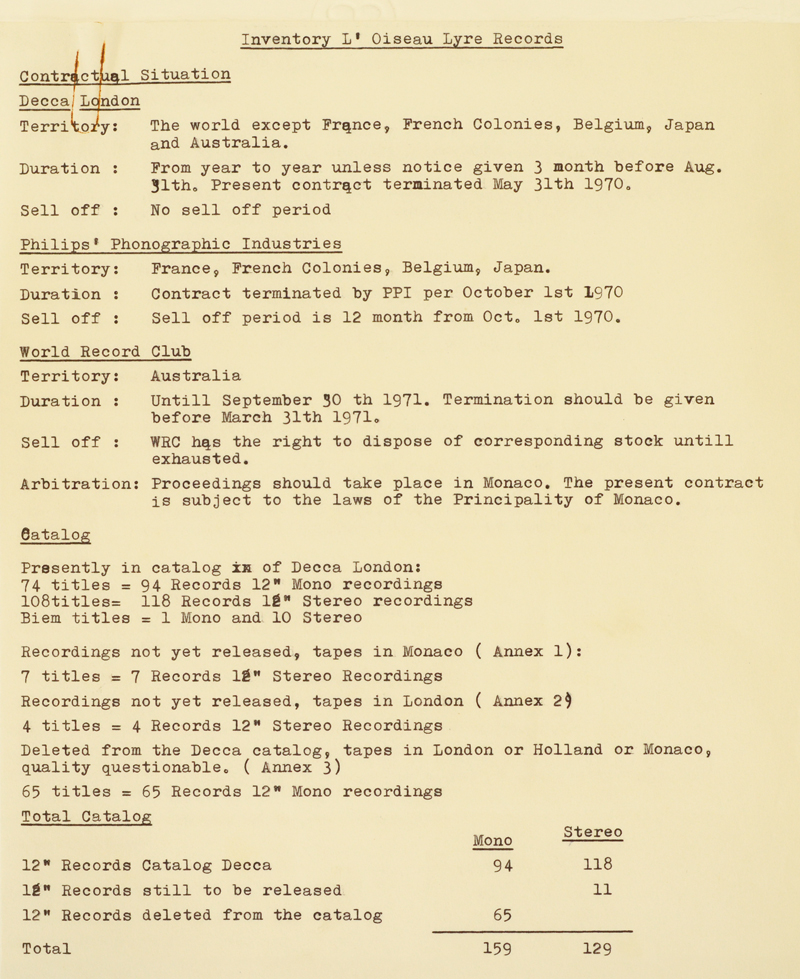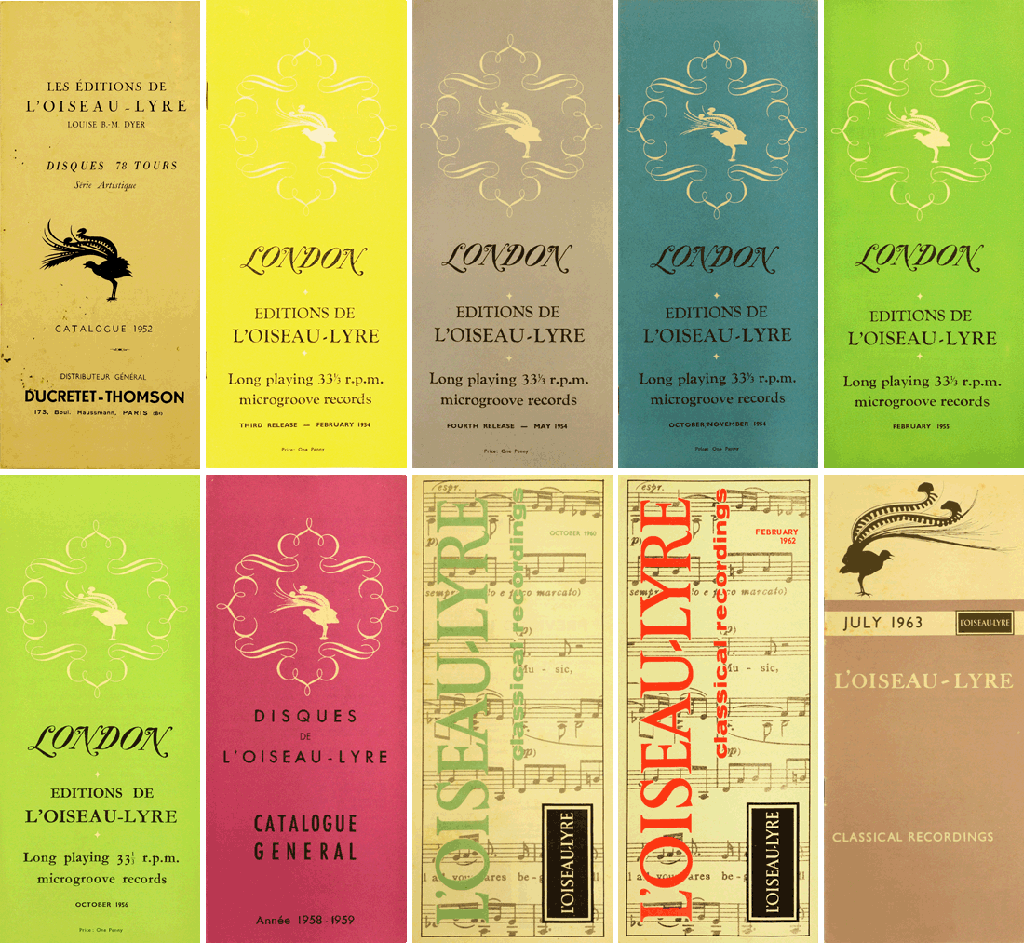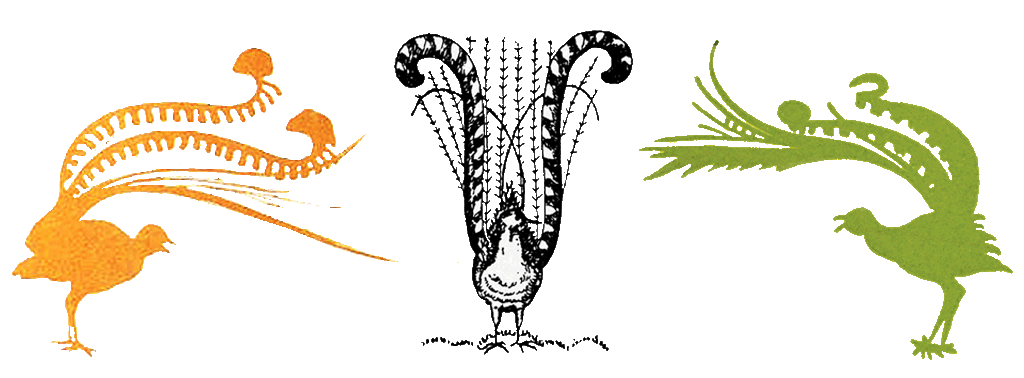L'OISEAU LYRE after LOUISE B. M. DYER

After Louise passed away in 1962, J. B. HANSON had continued l'OISEAU LYRE activity, as much for press publication as record manufacturer.
In 1970, long after Louise had disappeared, J. B. HANSON decided to sell the record label l'Oiseau Lyre, to the DECCA Company with which he had collaborated since 1953.
During the first quarter of 1970, J. B. HANSON began looking for a buyer for the record company L'OISEAU LYRE. He asked to CBS, DECCA and PHILIPS.
After studying the offer, CBS declined. On the other hand PHILIPS seems very interested and engages discussions with J. B. HANSON.
PHILIPS was the second partner after DECCA.
The third authorized distributor was WRC, World Record Club, an Australian company. Its territory: Australia. Since the beginning, Australia, Louise native country, had been considered as a private territory.

Document archives de l’oiseau Lyre University of Melbourne.
Prior to sale the company, J. B. HANSON had to terminate the current distribution contracts.
Collaboration with DECCA.
The collaboration between DECCA and L’OISEAU LYRE dates back to the 1950s. The first discussions dating back to 1951.
The first official agreement have been signed in 1953.
At the end of this agreement, DECCA became the main service provider for the manufacture and pressing of records and obtained the distribution of L’OISEAU LYRE records for a list of countries.
In 1957, in addition to the recordings in France, the OISEAU LYRE also undertook to make recordings in England and entrusted with DECCA to provide technical service.
From October 1957, DECCA confirmed the possibility to record all the sessions in stereo with price increase both for the recording and for the editing. Editing will be priced by the hour.
End of November 1957 we noticed a certain number of dates for recordings in London. Works by BACH and HAYDN specifically.
Since this time the majority recordings will be made by DECCA in England.
Since 1962 DECCA is the sole service provider for the OISEAU LYRE editions, taking charge of recordings, cutting and pressing.
There will be no more cutting nor pressing in France.
The tapes, recorded in Paris, are sent directly to DECCA for cutting and pressing.
On July 29, 1964 the revision of the contract confirms DECCA in its position of distributor for the whole world except France, French colonies, Belgium, Japan and Australia, with the right to press l’OISEAU LYRE records under the l’OISEAU LYRE brand.
PHILIPS, for its part, had distribution in territories not covered by DECCA.
Independently of the status of distributor, PHILIPS had the right to press under its own brand with its own references recordings which were no longer in the current l'OISEAU LYRE catalog.
The contract with DECCA is terminated on August 31, 1970.
Discussions with PHILIPS sucked down… the fault of who, we will never know.
It seems that J. B. HANSON does not make much effort to materialize with PHILIPS, nevertheless a handwritten note from him specifing that there is no peculiar animosity towards PHILIPS, but that there is no reason not to give preference to DECCA who has done an admirable job for 17 years.
In short, PHILIPS is definitively put out of the race and it is DECCA which, by contract dated December 9, 1970, wins and acquires the editions de L’OISEAU LYRE record company.
It is interesting to notice that the PHILIPS proposal was financially more attractive but J. B. HANSON finally decided in favor of DECCA because of the long-standing partnership and historical relationship between the 2 companies.
J. B. HANSON died in 1971.
Margarita, his second marriage widow, continues the publishing activity of the Editions de l'OISEAU LYRE until 1996.
In 1986 Margarita HANSON made donation of manuscripts and scores of early European music to the university of Melbourne.
Louise B. M. DYER was an exceptional woman who contributed to the promotion of music from the 13th to the 18th century.
The collection of the HANSON-DYER music library of the University of Melbourne comprises some 250 documents largely devoted to European music.
The collection focused largely on the work of LULLY and COUPERIN, but also on their contemporaries and successors, CAMPRA, RAMEAU, PHILIDOR and many others.
Beside French music, the collection also includes works from English composers: BLOW and PURCELL among others, as well as works from the Italian and German Renaissance.
Many scores in this collection are manuscripts.
Editions de l’OISEAU LYRE was The Great Work of LOUISE B. M. DYER.

Document archives de l’oiseau Lyre University of Melbourne.
How to understand clearly the numbering of l'OISEAU LYRE records?
The references of l'OISEAU LYRE records.
We only took care in records after 1949.
The complication of the L’OISEAU LYRE catalog is to have different numberings according to the geographical areas.
There is a numbering for the French market and another for the international records cut and pressed in England by DECCA under the brand LONDON L’OISEAU LYRE.
The French references are in OL LD - OL for OISEAU LYRE, and LD for Longue Durée, cutting made by André CHARLIN and pressing carried out In France at Chatou.
The so-called “international” numbering - OL 50 000 - only concerns LP records and does not mention LD or LP.
We find the same records in French numbering and in international numbering. For certain records made in Paris by André CHARLIN, it appears that French pressing is of lower quality that the English one pressed at DECCA. In this condition the French pressing is forgotten and not released.
The OL LD discs reference stoped when L’OISEAU LYRE decided to cut and press everything in England.
At this time, original tapes of the recordings made in France are sent to London for cuttind and pressing at DECCA.
Under the OISELET record label reference DO, OISEAU LYRE proposed reduced versions on 25 cm (10inches) records.
The listing of the OISEAU LYRE catalogue is not simple.
Looking at OISEAU LYRE catalogue is facing a fairly complicated puzzle.
At the beginning of stereophony, there is a double catalog, with mono references and stereo references.
The public is not yet ready to blinfold buy stereo-only discs.
Mono discs are referenced OL 50XXX and stereo discs SOL 60XXX.
The SOL stereo numbering will cover SOL discs 60001 through SOL 60052.
Mono references has nothing to do with stereo one.
Therafter a common Mono/Stereo referencing appears since the OL 250 / SOL 250.
The mono reference is OL XXX and the stereo reference SOL XXX but the record number is identical in both references.
This numbering will go up to disc N° OL 305 / SOL 305.
Later, when stereophonic LP had definitively conquered the market, the mono catalog will be definitely abandonned for the sole benefit of the SOL XXX refernce from stereo catalog.
Mono LP
OL 50 000 - International reference in the LONDON OISEAU LYRE / DECCA catalogue.
OL-LD 00 - French catalogue reference with French pressing.
Stereo LP
SOL 60 000 - Stereo Disc from issued from a stereo recording.
OLS 100 – “Stereo” disc electronicaly simulated from an original mono recording.
Common numbering
From OL 250 / SOL 250 to OL 305 / SOL 305
The OL reference indicates a mono record while the SOL reference indicates a stereo one.
At the end of mono disks unique SOL reference subsists.
Master tapes
Mono recordings Master tapes are numbered TT 000.
(Original monophonic recording)
“stereo simulated” Master tapes are numbered ETT 000.
(These tapes are issued from an original monophonic recording - the ETT reference is the same tape as the Original Mono TT)
Stereo recordings Master tapes are numbered ZTT 000
(Original stereo recording)
When a stereo recording is dub in mono, the mono master tape number is identical to the stereo master tape number TT xx and ZTT xx.

All my thanks to Jennifer HILL, curator of the special collection of rare and ancient music at the BAILLIEU Library of the University from Melbourne and to her whole team without whom these modest lines could never have been written.
You can also consult the pages concerning André CHARLIN and l'OISEAU LYRE
and the list of recordings André CHARLIN made on behalf of l'OISEAU LYRE.



